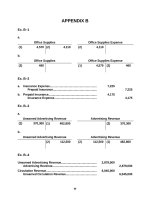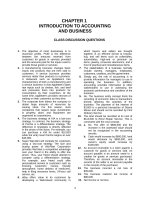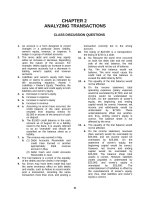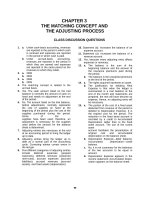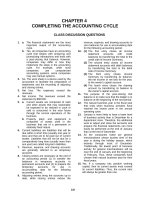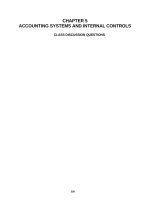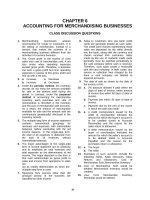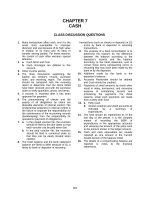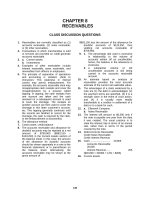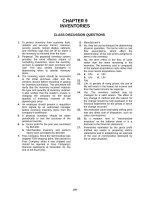Solution manual accounting 21e by warreni ch 19
Bạn đang xem bản rút gọn của tài liệu. Xem và tải ngay bản đầy đủ của tài liệu tại đây (236.67 KB, 74 trang )
CHAPTER 19
PROCESS COST SYSTEMS
CLASS DISCUSSION QUESTIONS
1. a. A job order cost system is best suited
for a custom jewelry manufacturer
because most of the production
consists of job orders, and costs can be
reasonably identified with each job.
b. A process cost system would be best
suited for a paper manufacturer
because the processes are continuous
and the products are homogeneous.
c. A job order cost system is best suited
for an automobile repair shop because
costs can be reasonably identified with
each job.
d. A job order cost system would be used
by a building contractor to accumulate
the costs for each individual building
because the costs can be identified
with each job without great difficulty.
e. An assembly-type industry using mass
production methods, such as TV
assembly, would use the process cost
system because the products are
somewhat standard and lose their
identities as individual items. In such
industries, it is neither practical nor
necessary to identify output by jobs.
2. Since all goods produced in a process cost
system are identical units, it is not
necessary to classify production costs into
job orders.
3. In a process cost system, the direct labor
and factory overhead applied are debited to
the work in process accounts of the
individual production departments in which
they occur. The reason is that all products
produced by the department are similar.
Thus, there is no need to charge these
costs to individual jobs. For the process
manufacturer, the direct materials and the
conversion costs are charged to the
department and divided by the completed
production of the department to determine
a cost per unit.
4. Transferred-out materials are materials that
are completed in one department and
transferred to another department or to
finished goods.
5. (1) Determine the units to be costed.
(2) Calculate the equivalent units of
production.
(3) Determine the cost per equivalent unit.
(4) Allocate costs to completed and
partially completed units.
6. Equivalent units is the term used to
represent the total number of units that
would have been completed within a
processing department as a result of the
productive efforts during a period had there
been no work in process at the beginning
or end of the period. Equivalent units may
be said to measure the productive activity
for a given period.
7. The cost per equivalent unit is frequently
determined separately for direct materials
and conversion costs because these two
costs are frequently incurred at different
rates in the production process. For
example, materials may be incurred at the
beginning of the process and conversion
costs incurred evenly throughout the
process.
8. The cost per equivalent unit is used to
allocate direct materials and conversion
costs between completed and partially
completed units.
9. The transferred-in cost from Department A
to Department B includes the materials
costs, direct labor, and applied factory
overhead incurred to complete units in
Department A.
10. Actual factory overhead incurred is debited
to departmental factory overhead accounts.
11. The most important purpose of the cost of
production report is to assist in the control
of costs. This is accomplished by holding
each department head responsible for the
costs incurred in the department.
12. Cost of production reports can provide
detailed data about the process. The
reports can provide information on the
department by individual cost elements.
This
can
enable
management
to
investigate problems and opportunities.
39
13. Yield is a measure of the materials usage
efficiency of a process manufacturer. It is
determined by dividing the output volume
of product by the input volume of product.
For example, if 950 tons of aluminum were
rolled from 1,000 tons of ingot, then the
yield would be said to be 95%. Five percent
of the ingot was scrapped during the rolling
process.
14. Just-in-time processing is a business
philosophy that focuses on reducing time
and cost and eliminating poor quality within
processes.
15. Just-in-time
processing
emphasizes
combining
process
functions
into
manufacturing cells, involving employees in
process improvement efforts, eliminating
wasteful activities, and reducing the
amount of work in process inventory
required to fulfill production targets.
40
EXERCISES
Ex. 19–1
a.
Work in Process—Blending Department......................
Materials—Cocoa beans..........................................
Materials—Sugar......................................................
Materials—Dehydrated milk.....................................
XXX
b. Work in Process—Molding Department.......................
Work in Process—Blending Department................
XXX
c.
Work in Process—Packing Department.......................
Work in Process—Molding Department..................
XXX
d. Finished Goods.............................................................
Work in Process—Packing Department..................
XXX
e.
XXX
Cost of Goods Sold.......................................................
Finished Goods........................................................
XXX
XXX
XXX
XXX
XXX
XXX
XXX
Ex. 19–2
Materials
Factory Overhead—
Smelting Dept.
Work in Process—
Smelting Dept.
Factory Overhead—
Rolling Dept.
Work in Process—
Rolling Dept.
Finished Goods—
Rolled Sheet
Factory Overhead—
Converting Dept.
Work in Process—
Converting Dept.
Finished Goods—
Sheared Sheet
Cost of Goods
Sold
Ex. 19–3
a.
1. Work in Process—Refining Department.................
Materials..............................................................
245,000
2. Work in Process—Refining Department.................
Wages Payable....................................................
112,000
3. Work in Process—Refining Department.................
Factory Overhead—Refining Department..........
81,600
b. Work in Process—Sifting Department..........................
Work in Process—Refining Department.................
245,000
112,000
81,600
424,600*
424,600
*$24,000 + $245,000 + $112,000 + $81,600 – $38,000
Ex. 19–4
a.
Factory overhead rate:
$936,000 ÷ $780,000 = 120%
b. Work in Process—Blending Department......................
Factory Overhead—Blending Department..............
$64,500 × 120% = $77,400
77,400
77,400
c. $2,400 credit
d. Overapplied factory overhead
Ex. 19–5
Whole Units
Inventory in process, beginning
(75% completed).......................
Started and completed..................
Transferred to Packing Dept.........
Inventory in process, ending
(40% complete).........................
Total................................................
*13,500 – 1,800
Equivalent Units
Direct Materials Conversion
1,800
11,700*
13,500
0
11,700
11,700
450
11,700
12,150
1,200
14,700
1,200
12,900
480
12,630
Ex. 19–6
a.
Drawing Department
Whole Units
Inventory in process, July 1
(35% completed)...........................
Started and completed in July..........
Transferred to Winding Department
in July............................................
Inventory in process, July 31
(80% complete).............................
Total....................................................
Equivalent Units
Direct Materials Conversion
4,500
81,500*
0
81,500
2,925
81,500
86,000
81,500
84,425
5,400
5,400
4,320
91,400
86,900
88,745
*86,000 – 4,500
b. Winding Department
Whole Units
Inventory in process, July 1
(55% completed)...........................
Started and completed in
July................................................
Transferred to finished goods
in July............................................
Inventory in process, July 31
(18% complete).............................
Total....................................................
2,000
Equivalent Units
Direct Materials Conversion
0
900
82,800*
82,800
82,800
84,800
82,800
83,700
3,200
3,200
576
88,000
86,000
84,276
*84,800 – 2,000
Note: Of the 86,000 units transferred in, 82,800 units were started and completed
and 3,200 units are in ending work in process.
Ex. 19–7
a.
Units in process, July 1..............................................
Units placed into production for July.......................
Less units finished during July.................................
Units in process, July 31............................................
b.
Whole Units
Inventory in process, July 1
(3/5 completed).............................
Started and completed in July..........
Transferred to finished goods
in July............................................
Inventory in process, July 31
(2/3 complete)...............................
Total....................................................
*175,000 – 10,000
10,000
180,000
(175,000)
15,000
Equivalent Units
Direct Materials Conversion
10,000
165,000*
0
165,000
4,000
165,000
175,000
165,000
169,000
15,000
15,000
10,000
190,000
180,000
179,000
Ex. 19–8
a.
1. $2.20 ($396,000/180,000 units)
2. $7.80 [($558,480 + $837,720)/179,000 units]
3. $98,200, determined as follows:
Work in Process—Finishing Department Balance, July 1........
Conversion costs incurred during July
(4,000 equivalent units × $7.80)...............................................
Cost of beginning work in process completed during July.....
$ 67,000
31,200
$ 98,200
4. $1,650,000 [($2.20 + $7.80) × 165,000 units]
Note to Instructors: The cost of the beginning work in process completed
during July, $98,200, plus the cost of the units started and completed
during July, $1,650,000, equals the cost of the units finished during July,
$1,748,200.
5. $111,000, determined as follows:
Direct materials ($2.20 × 15,000 units).......................................
Conversion costs ($7.80 × 10,000 equivalent units).................
Cost of ending work in process.................................................
$ 33,000
78,000
$111,000
Note: The cost of ending work in process is also the balance of the Work
in Process—Finishing Department account as of July 31.
b. The conversion costs in July increased by $0.30 per equivalent unit,
determined as follows:
Work in Process—Finishing Department Balance, July 1.............
Deduct direct materials cost incurred in June
($2.20 × 10,000 units)...................................................................
Conversion costs incurred in June.................................................
$ 67,000
22,000
$ 45,000
June conversion cost per equivalent unit
[$45,000/(10,000 units × 3/5]........................................................
$7.50
July conversion cost per equivalent unit.......................................
Less June conversion cost per equivalent unit.............................
Increase in conversion cost per equivalent unit............................
$7.80
7.50
$0.30
Ex. 19–9
Equivalent units of production:
Cereal
(in pounds)
Inventory in process, October 1..........
Started and completed in October......
Transferred to finished goods
in October........................................
Inventory in process, October 31........
Total.......................................................
Boxes
Conversion Cost
(in boxes)
(in boxes)
—
34,200
—
22,800
1,200
22,800
34,200
900
35,100
22,800
500
23,300
24,000
—
24,000
Supporting explanation:
The inventory in process on October 1 includes both the cereal in the hopper and
the boxes in the carousel, and thus, includes no equivalent units for the material
during the current period. The reason is because the costs for the cereal and
boxes were introduced to the Packing Department in September. Since
conversion costs are incurred only when the cereal is filled into boxes, all 1,200
boxes of the October 1 inventory in process will have conversion costs incurred
in October.
The product started and completed in October includes 22,800 boxes (24,000
boxes completed less the 1,200 in the carousel on October 1). These boxes
represent 34,200 pounds of cereal (22,800 × 24 oz./16 oz.), since there are 16
ounces to a pound. Alternatively, there were a total of 36,000 pounds of cereal
boxed during October (24,000 boxes × 24 oz./16 oz.); however, 4,800 of these
pounds were already introduced in September and accounted for in the October 1
inventory in process.
The inventory in process on October 31 includes the remaining pounds of cereal
in the hopper and boxes in the carousel that are properly included in the
equivalent unit computation for October (since the costs were incurred in the
department in October). No conversion costs have been applied to these boxes
since they remain unfilled.
Note to Instructors: An actual cereal-filling line begins with the empty box
carousel. The box carousel holds flattened boxes that are fed into a high-speed
line that opens the box up and places it on a conveyor. The conveyor brings the
opened box under a filler head. The cereal pours from the hopper through the
filler head into the open box (actually into the inner sealer bag). The box then
moves down the line to be boxed into a large shipping carton, which is then
moved to the warehouse.
Ex. 19–10
a.
Direct labor..........................................................................................
Factory overhead applied...................................................................
Total conversion cost.........................................................................
$ 69,720
29,880
$ 99,600
b. Equivalent units of production for conversion costs:
Beginning inventory......................................................................
Started and completed..................................................................
Ending inventory (3/5 × 7,500 units).............................................
Total equivalent units for conversion costs................................
0
120,000
4,500
124,500
Conversion cost per equivalent unit:
$99,600
= $0.80 conversion cost per equivalent unit
124,500
c.
Equivalent units of production for direct materials costs:
Beginning inventory......................................................................
Started and completed..................................................................
Ending inventory (all units completed as to direct materials)....
0
120,000
7,500
Total equivalent units for direct materials costs.........................
127,500
Direct materials cost per equivalent unit:
$474,300
= $3.72 direct materials cost per equivalent unit
127,500
Ex. 19–11
a.
Units in process at beginning of period......................................
Units placed in production during period...................................
Less units finished during period................................................
Units in process at end of period.................................................
2,500
56,000
(54,500)
4,000
b.
Whole Units
Inventory in process, beginning
(60% completed)...........................
Started and completed......................
Transferred to finished goods..........
Inventory in process, ending............
Total units...........................................
2,500
52,000*
54,500
4,000
58,500
Equivalent Units
Direct Materials Conversion
0
52,000
52,000
4,000
56,000
1,500
52,000
53,500
1,000
54,500
*54,500 – 2,500
c.
Costs
Direct Materials
Conversion
Total costs for period in
Assembly Department...................................
Total equivalent units
(from above)...................................................
Cost per equivalent unit.......................................
**$75,210 + $112,815
d.
$275,600 [($1.85 + $3.45) × 52,000 units]
$103,600
$ 188,025**
÷ 56,000
$
1.85
÷ 54,500
$
3.45
Ex. 19–12
a.
1. $13,400; determined as follows:
Beginning work in process balance..........................................
Conversion costs incurred during period
(1,500 equivalent units × $3.45).............................................
Cost of beginning work in process completed during July.....
2. Cost of beginning work in process............................................
Cost of units started and completed during period.................
Cost of units transferred to finished goods during period......
$ 8,225
5,175
$13,400
$ 13,400
275,600*
$289,000
*($1.85 + $3.45) × 52,000 units
3. $10,850; determined as follows:
Direct materials ($1.85 × 4,000 units)........................................
Conversion costs ($3.45 × 1,000 equivalent units)...................
Cost of ending work in process inventory................................
$ 7,400
3,450
$10,850
Note: The cost of ending work in process is also the ending balance of the
Work in Process—Assembly Department account.
4. $5.36 ($13,400/2,500 units)
b. Yes. The production costs per unit decreased during the current period. We
know this because the cost per unit of the units started and completed during
the period is $5.30 ($1.85 + $3.45). Since the cost per unit of the beginning
work in process completed during the period is $5.36 (see (4) above), the
production costs during the current period must have decreased.
c.
The conversion cost in the current period decrease by $0.15 per equivalent
unit; determined as follows:
Beginning work in process..............................................................
Deduct direct materials cost incurred in prior period
($1.85 × 2,500 units)....................................................................
Conversion costs incurred in prior period.....................................
Prior period conversion cost per equivalent unit
[$3,600/(2,500 units × 0.40)]........................................................
Less current period conversion cost per equivalent unit.............
Decrease in conversion cost per equivalent unit during
current period..............................................................................
$8,225
4,625
$3,600
$3.60
3.45
$0.15
Ex. 19–13
1.
In computing the equivalent units for conversion costs applicable to the April
1 inventory, the 4,500 units are multiplied by 2/3 rather than 1/3, which is the
portion of the work completed in April. Therefore, the equivalent units should
be 1,500 instead of 3,000.
2. In computing the equivalent units for conversion costs for units started and
completed in April, the April 1 inventory of 4,500 units, rather than the April 30
inventory of 6,200 units, was subtracted from 18,000 units started in the
department during April. Therefore, the equivalent units started and
completed should be 11,800 instead of 13,500.
3. The correct equivalent units for conversion costs should be 15,700,
determined as follows:
To process units in inventory on April 1:
4,500 × 1/3......................................................................................
1,500
To process units started and completed in April:
18,000 – 6,200................................................................................
11,800
To process units in inventory on April 30:
6,200 × 1/5......................................................................................
1,240
Equivalent units of production..........................................................
14,540
Ex. 19–14
a.
47,500 units (7,500 + 48,000 – 8,000)
b.
Whole Units
Inventory in process, November 1
(60% completed)..............................
Started and completed
in November....................................
Transferred to finished goods
in November....................................
Inventory in process, November 30
(25% complete)................................
Total units.............................................
7,500
Equivalent Units
Direct Materials Conversion
0
3,000
40,000*
40,000
40,000
47,500
40,000
43,000
8,000
8,000
2,000
55,500
48,000
45,000
*48,000 – 8,000
Costs
Direct Materials Conversion
Total costs for November in
Forging Department............................................
Total equivalent units
(from above)........................................................
Cost per equivalent unit............................................
c. $474,000 [40,000 units × ($8.25 + $3.60)]
$396,000
$162,000
÷ 48,000
$
8.25
÷ 45,000
$
3.60
Ex. 19–15
a.
b.
$86,550; determined as follows:
Beginning work in process balance..................................................
Conversion costs incurred during period
(3,000 equivalent units × $3.60).....................................................
Cost of beginning work in process completed during July............
$ 75,750
Cost of beginning work in process...................................................
Cost of units started and completed during period.........................
Cost of units transferred to finished goods during period.............
$ 86,550
474,000*
$560,550
10,800
$ 86,550
*($8.25 + $3.60) × 40,000 units
c.
$73,200; determined as follows:
Direct materials ($8.25 × 8,000 units)................................................
Conversion costs ($3.60 × 2,000 equivalent units)..........................
Cost of ending work in process inventory.......................................
$ 66,000
7,200
$ 73,200
Note: The cost of ending work in process is also the ending balance of the
Work in Process—Forging Department as of November 30.
d.
Direct materials cost per equivalent unit: $8.00 ($60,000/7,500 units)
Conversion cost per equivalent unit: $3.50 ($15,750/4,500 units)
Work in process, November 1........................................................
Less direct materials cost..............................................................
Conversion cost included in November 1, Work in Process.......
$ 75,750
60,000
$ 15,750
Equivalent units in November 1, Work in Process (7,500 × 60%) = 4,500 units
e.
Direct materials: Increase of $0.25 ($8.25 – $8.00)
Conversion: Increase of $0.10 ($3.60 – $3.50)
Ex. 19–16
EUPHRATES COMPANY
Cost of Production Report—Cooking Department
For the Month Ended January 31, 2006
Units
Units charged to production:
Inventory in process, January 1. .
Received from materials
storeroom................................
Total units accounted for by the
Cooking Department...............
Units to be assigned cost:
Inventory in process, January 1
(30% completed)......................
Started and completed in
January....................................
Transferred to finished goods
in January................................
Inventory in process, January 31
(25% complete)........................
Total units to be assigned cost. . .
Whole Units
Equivalent Units
Direct Materials Conversion
(a)
(a)
1,500
63,500
65,000
1,500
0
1,050
61,700*
61,700
61,700
63,200
61,700
62,750
1,800
1,800
450
65,000
63,500
63,200
*63,500 – 1,800
Continued
Ex. 19–16
Concluded
Costs
Direct Materials
Unit costs:
Total costs for January in
Cooking Department...............
Total equivalent units...................
Cost per equivalent unit (b).........
$177,800
÷ 63,500
$
2.80
Costs
Conversion
$278,080
÷ 63,200
$
4.40
Costs charged to production:
Inventory in process,
January 1.................................
Costs incurred in January............
Total costs accounted for by
the Cooking Department.........
Costs allocated to completed and
partially completed units:
Inventory in process,
January 1 balance....................
To complete inventory in
process, January 1..................
Started and completed
in January................................
Transferred to finished
goods in January (c)...............
Inventory in process,
January 31 (d)..........................
Total costs assigned by
the Cooking Department.........
1
2
3
4
5
1,050 units × $4.40
61,700 units × $2.80
61,700 units × $4.40
1,800 units × $2.80
450 units × $4.40
Total Costs
$ 6,753
455,880
$462,633
$
$
0
172,7602
$
6,753
4,6201
4,620
271,4803
444,240
$455,613
5,0404
1,9805
7,020
$462,633
Ex. 19–17
BOGART CARPET COMPANY
Cost of Production Report—Cutting Department
For the Month Ended March 31, 2006
Units
Units charged to production:
Inventory in process, March 1......
Received from Weaving
Department..............................
Total units accounted for by the
Cutting Department.................
Units to be assigned cost:
Inventory in process, March 1
(75% completed)......................
Started and completed in March..
Transferred to finished goods
in March...................................
Inventory in process, March 31
(40% complete)........................
Total units to be assigned cost. . .
Whole Units
Equivalent Units
Direct Materials Conversion
(a)
(a)
8,000
215,000
223,000
8,000
206,000*
0
206,000
2,000
206,000
214,000
206,000
208,000
9,000
9,000
3,600
223,000
215,000
211,600
*215,000 – 9,000
Continued
Ex. 19–17
Concluded
Costs
Direct Materials
Unit costs:
Total costs for March in
Cutting Department................. $ 1,128,750
Total equivalent units................... ÷ 215,000
Cost per equivalent unit............... $
5.25
Costs
Conversion
$ 1,005,100
÷ 211,600
$
4.75
Costs charged to production:
Inventory in process,
March 1.....................................
Costs incurred in March...............
Total costs accounted for by
the Cutting Department...........
Costs allocated to completed and
partially completed units:
Inventory in process,
March 1 balance.......................
To complete inventory in
process, March 1..................... $
0
Started and completed
in March...................................
1,081,5002
Transferred to finished
goods in March........................
Inventory in process,
March 31...................................
47,2504
Total costs assigned by
the Cutting Department...........
1
2
3
4
5
2,000 units × $4.75
206,000 units × $5.25
206,000 units × $4.75
9,000 units × $5.25
3,600 units × $4.75
Total Costs
$
70,400
2,133,850
$ 2,204,250
$
$
70,400
9,5001
9,500
978,5003
2,060,000
$ 2,139,900
17,1005
64,350
$ 2,204,250
Ex. 19–18
a.
1. Work in Process—Casting Department..................
Materials—Alloy..................................................
249,200
2. Work in Process—Casting Department..................
Wages Payable....................................................
Factory Overhead................................................
*$162,540 × 150%
406,350
3. Work in Process—Machining Department..............
Work in Process—Casting Department.............
673,450*
249,200
162,540
243,810*
673,450
*Supporting calculations:
Cost of 9,250 transferred-out pounds:
Inventory in Process, October 1...................................................
Cost to complete October 1 inventory:
450 pounds × $45/lb. (see calculations below)......................
Pounds started and completed in October
[8,500 lbs. × ($28 + $45)]..........................................................
Transferred to Machining Department..........................................
$ 32,700
20,250
620,500
$673,450
Supporting equivalent unit and cost per equivalent unit calculations:
Equivalent Units
Whole Units Materials Conversion
Inventory in process, October 1
(40% completed)............................
Started and completed in October.....
Transferred to finished goods in
October...........................................
Inventory in process, October 31
(20% complete)..............................
Total......................................................
Cost per equivalent unit of materials:
750
8,500
—
8,500
450
8,500
9,250
8,500
8,950
400
9,650
400
8,900
80
9,030
$249,200
= $28 per pound
8,900
Cost per equivalent unit of conversion:
$406,350
= $45 per pound
9,030
Ex. 19–18
Concluded
b. $14,800; determined as follows:
Direct materials (400 × $28).....................................
Conversion (400 × 20% × $45).................................
or
$14,800 = $32,700 + $249,200 + $406,350 – $673,450
$ 11,200
3,600
$ 14,800
Ex. 19–19
Memo
To: Production Manager
The cost of production report was used to identify the cost per case for each of
the four flavors as shown below.
Total cost...............................
Number of cases...................
Cost per case........................
Orange
Cola
Lemon-Lime
Root Beer
$ 15,800
÷ 4,000
$
3.95
$ 99,300
÷ 30,000
$
3.31
$ 65,200
÷ 20,000
$
3.26
$ 9,400
÷ 2,000
$ 4.70
As can be seen, the cost per case of Root Beer is significantly above the cost per
case of the other three flavors. A more detailed analysis is necessary. The
individual cost elements that determine the total cost can be divided by the
number of cases. This analysis is provided below.
Cost per Case by Cost Element
Orange
Cola
Lemon-Lime Root Beer
Concentrate................................
Water...........................................
Sugar..........................................
Bottles........................................
Flavor changeover.....................
Conversion cost.........................
Total cost per case.....................
$0.90
0.30
0.50
1.10
0.75
0.40
$3.95
$1.10
0.30
0.50
1.10
0.06
0.25
$3.31
$1.05
0.30
0.50
1.10
0.06
0.25
$3.26
$0.90
0.30
0.50
1.10
1.50
0.40
$4.70
The table above indicates that the concentrate per case is actually less for
Orange and Root Beer than for Cola and Lemon-Lime. This is because the
concentrate supplier charges a higher price for the more popular flavors. The
costs per case for water, sugar, and bottles are the same for each flavor. However,
the costs per case for changeover are much greater for Orange and Root Beer
than for the other two flavors. In addition, the conversion costs per unit for
Orange and Root Beer are $0.15 higher than for Cola and Lemon-Lime. These last
two cost elements are sufficient to cause the cost per case of Orange and Root
Beer to be greater than Cola and Lemon Lime.
Although further analysis is necessary, it appears that Orange and Root Beer are
either bottled in short production runs, meaning more frequent changeovers, or
that each Orange and Root Beer changeover is very difficult and expensive. The
conversion cost per case is larger because the bottling line rate appears slower
for Orange and Root Beer, compared to Cola and Lemon-Lime. It’s possible that
shorter run sizes are related to the slower line rate because it takes some run
time to work the line rate up to a fast speed after a changeover. Root Beer costs
more per case than Orange because it has the shortest run length.
Ex. 19–20
The solution to this exercise is to determine if cost per pound trends in materials,
conversion, and coating costs are remaining stable over time. The following table
can be developed from the data:
January
Transferred-in materials
($ ÷ pounds output).......
Coating cost
($ ÷ pounds output).......
Conversion cost
($ ÷ pounds output).......
Yield (pounds transferred
out ÷ pounds input)........
February March
$0.35
April
May
June
$0.35
$0.35
$0.35
$0.35
$0.35
0.10
0.11
0.125
0.14
0.145
0.16
0.25
0.25
0.25
0.25
0.25
0.25
1.92
1.92
1.92
1.92
1.92
1.92
The cost per pound information is determined by dividing the costs by the
pounds transferred out. The yield is determined by dividing the pounds
transferred out by the pounds input.
Operator 1 believes that energy consumption is becoming less efficient. The
energy cost is part of the conversion cost. The conversion cost per output pound
has remained constant for the six months. If the energy efficiency were declining,
it would take more energy per pound of output over time. Thus, we would expect
to see the conversion rate per pound increasing if Operator 1 were correct.
Operator 2 believes that there are increasing materials losses from increasing
startup and shutdown activity. Yield data would help determine if this were true. If
materials losses were growing, then there would be less materials transferred out
per pound of inputs over time. The yield has remained constant over the sixmonth period. Thus, Operator 2’s hypothesis is not validated. This is also
supported by the constant materials rate per output pound.
Operator 3 is concerned about coating costs. The coating cost per output pound
is increasing over time. Thus, we can conclude that the coating efficiency is
declining over time. Apparently, more coating material was being spread per
pound of output in June than in January. The coating operation may need to be
repaired or recalibrated. Too much coating is being spread on the film.
Ex. 19–21
The Casagrande Machining managers are displaying typical fears to a just-in-time
processing system. Just-in-time removes the safety provided by materials, inprocess, and finished goods inventory balances. Indeed, these types of
comments reflect conventional manufacturing philosophy, which views inventory
as a necessary buffer against surprises and other unwelcome events. The just-intime philosophy focuses on removing the causes that require a need for
inventory.
In the case of materials inventories, a just-in-time philosophy requires all
suppliers to provide high-quality materials on a daily basis in just the right
quantities needed for a day’s production. If the supplier has unreliable production
schedules or quality, then the sources of unreliability would need to be fixed
before moving to just-in-time delivery. Only when suppliers are reliable can
Casagrande Machining move to a just-in-time strategy without exposing the
company to significant risk.
The in-process inventories can be reduced significantly if the underlying
manufacturing processes are made reliable. The Director of Manufacturing is
correct in his observation, but his solution is wrong. The solution is not to
increase inventory but to improve the reliability of the machines so that they do
not experience emergency breakdowns. Thus, the manufacturing operation must
be improved to produce the right product, in the right quantities, at the right
quality, and at the right time. Only with this level of reliability can a plant
responsibly remove in-process inventories from the system.
The finished goods inventory can also be reduced if the manufacturing system
can be made responsive to customer demands. A company will no longer have to
stock warehouses with product based on guesses at what the customer will want
many weeks ahead of demand. Rather, goods are produced at the time the
customer orders them. This is what Dell Computer Corporation does. It builds a
computer to order, rather than stocking the computer and selling it from
inventory.
In other words, inventory covers a “multitude of sins.” When the “sins” are
removed, the inventory can be removed.
Appendix Ex. 19–22
a. and b.
Whole Units
Units to be accounted for:
Beginning work in process..............
Units started during period..............
Total........................................................
Units to be assigned costs:
Transferred to Packing Dept............
Inventory in process, ending
(30% complete)..............................
Total........................................................
*10,500 – 1,200 + 600
Equivalent Units
of Production
1,200
9,900*
11,100
10,500
10,500
600
11,100
180
10,680
